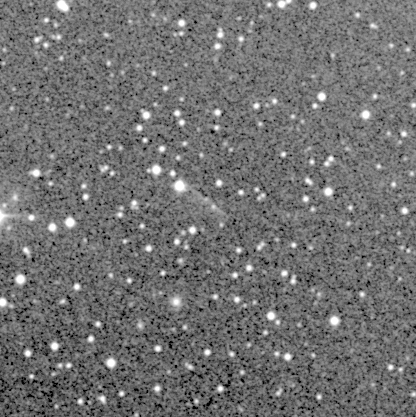
163P/NEAT on 1997-11-26 in Haleakala-NEAT/GEODSS images.
The story of this precovery is quite different compared to my earlier since unlike the others this was a effort of long weeks that finally came to a successful end.
After the discovery of comet P/2004 V4 (NEAT) and the first orbital update with ONS prediscovery observations nearly a month prior discovery I found out that this comet had a good chance to be located in NEAT archival data of 1997. Realising that the orbital arc was still too short to do extensive searches I asked several observers to provide me with astrometry immediately after observation. Several observers like Luca Buzzi (204), Peter Kocher (A16) and Filip Fratev (A61) kindly sent me their observations. The orbit grew steadily more stable and still three nights were shown as candidates in NEAT data of 1997.
However, nothing positive was found. I calculated a range of orbits, extended the search radius in the images but finally tended more and more to the conclusion that the comet is unusually bright at the current apparition. In the end I had even given up calculating own orbits and simply used the MPC orbits which were published in the weekly updates.
On the evening of Dec. 09, 2004, I decided to have a short look at the comet again and - something I never did for newly discovered comets with a short arc - used the JPL orbit for checking. Interestingly now only two NEAT images of 1997 were shown, which I downloaded immediately and checked for the comet. Again I found nothing positive. But just before I closed the images I saw something that looked like the typical image errors of the early NEAT data: an elliptical faint blob moving in the right direction.

163P/NEAT on 1997-11-26 in Haleakala-NEAT/GEODSS images.
I was more than skeptical but quickly measured the images and re-caluclated the orbit. The result was promising since the residuals of the two observations were small. But this could be just a coincidence and no proof. This single night was not worth anything if I could not find another night. So I fed the updated orbit into the software and was disappointed that still only these two images of 1997 were indicated. I then - without much hope - checked the DSS data and found three promising plates of 1990/1991. But these were not so safe candidates: On one hand the brightness was of course uncertain and the objects may have been too faint and on the other hand in all three images the object was placed near the edge of the field, i.e the object may be well off the edge.
Of course I gave it a try and couldn't believe when all three images appeared on my screen and on all three images a trail was seen right at the centre. Especially the one of 1991 showed a nice long trail, slightly diffuse and a faint tail.

163P/NEAT on 1990-10-24. © Caltech/Palomar and AURA/STScI.

163P/NEAT on 1990-10-26. © Caltech/Palomar and AURA/STScI.

163P/NEAT on 1991-02-09. © Caltech/Palomar and AURA/STScI.
I quickly measured the images and composed a message to the MPC and Brian G. Marsden. Well, I have to admit that I did it too quickly since I made some errors with the data formatting which I had to explain in some follow-up e-mails. Finally MPEC 2004-X29 was published (still containing one error: the letter C prior the year for the 1990/91 observations should have been left out) confirming the now three observed apparitions of this comet. Finally this will lead to a permanent numbering of this comet, most likely 163P/NEAT.
The three precoveries by myself which lead to permanent numberings are all for survey comets: 159P/LONEOS, 160P/LINEAR and now 163P/NEAT.
© 2004, M. Meyer